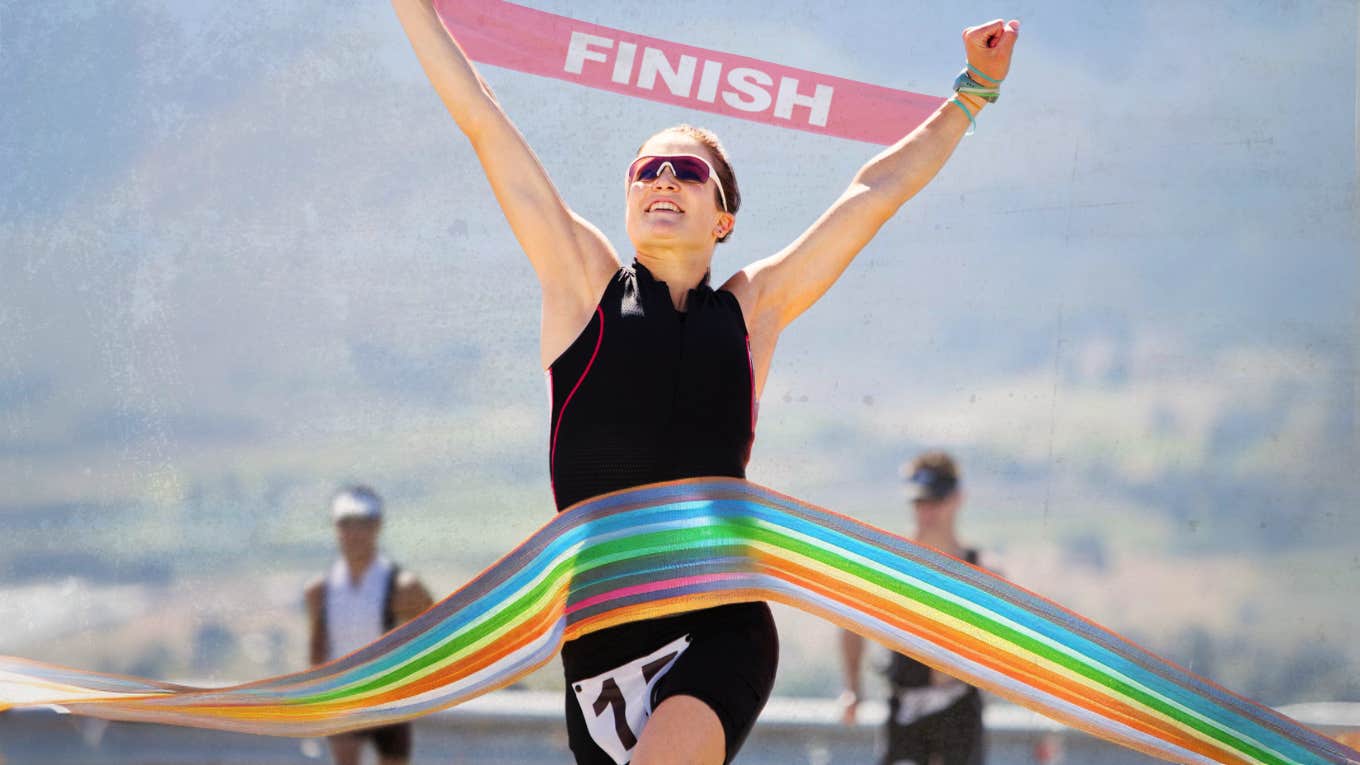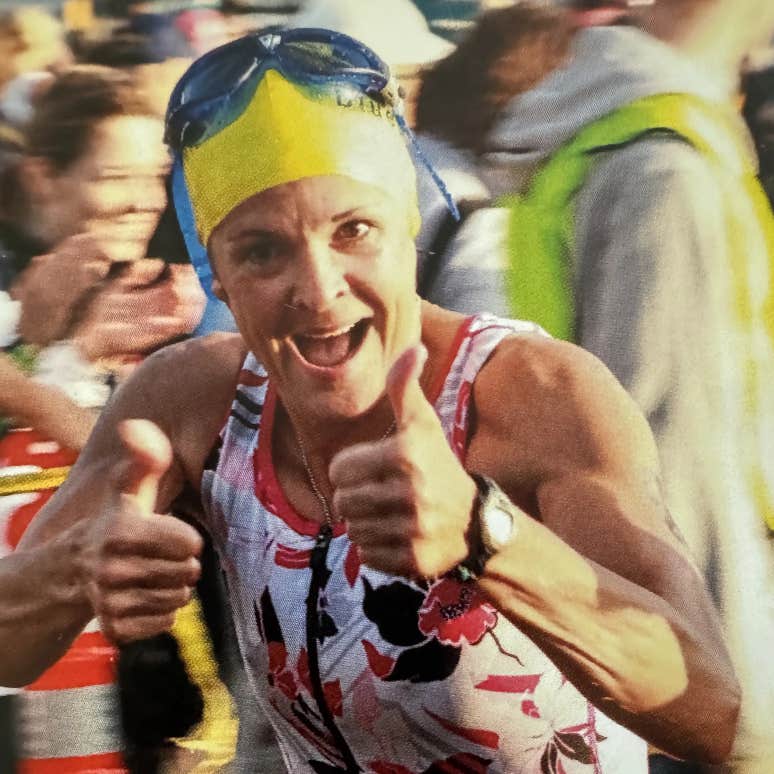Chronic Pain And Decades Of Hiding My Sexuality Nearly Destroyed Me. A Triathlon Saved Me.
Training for a triathlon helped me create a better life.
 Science Photo Library | Canva
Science Photo Library | Canva I feel myself shiver as I stand in waist-deep water, waiting for my race wave to be called to the starting line. My goggles and swim cap are on, and my arms are held tight to my body with hands clasped under my chin in an effort to keep warm.
Suddenly, I hear the woman behind me talking to herself in a panic, “What am I doing here? Why did I think this was a good idea? I have no idea what I’m doing here. What am I doing here?”
Her anxious energy seeps into my body as I absorb her words and sense her panic. She’s making me nervous, and I feel an almost uncontrollable urge to turn around and tell her to shut up, which is very out of character for me.
Instead, I focus on my training, reminding myself I worked hard to get here and that I’m ready.
The air horn blows harshly, startling many of us. I submerge myself and start to swim, only to get kicked in the face by the woman in front of me. I can’t stop because there is a surge of racers behind me, so I switch to breaststroke and attempt to get clear of the pack.
The water is choppy, and I swallow just enough Lake Washington water to make me cough. I struggle to catch my breath and start treading water, trying to settle my heart rate. Between my choppy breathing and the even choppier water, I feel fatigued and defeated and consider dropping out of the race.
Instead, something wells up in me like a wave gathering energy before it breaks, and I start talking to myself. Get in gear, Stamp. You trained for this, and you WILL finish this no matter how long it takes. Now go, get moving!
My internal monologue works, and I start swimming. Though this is my weakest leg of the race, I’m confident I can finish. I trained every week in open water to get more comfortable, and that experience propels me forward. With each stroke, I visualize coming out of the water and running to the transition area.
I sequence my movements in my mind, something I learned to do as a young girl to ease my anxiety and fear. I picture myself wading through the shallow water, stepping on the rocks until I reach the grassy area. I visualize taking off my cap and goggles, unzipping my wetsuit, and peeling the top half of it off. I remind myself where my transition spot is and what I need to do to get my bike ready.
Swimming around the final buoy, I concentrate on the shore and am elated when I complete the half-mile swim.
Exiting the water, I spot my girlfriend, who trained me for the race.
She keeps pace with me along the pathway, shouting encouragement. Her presence calms me.
I quickly find my bike, towel off, don my jersey and shoes, and head to the bike start, excited to make up some of the time I lost on the swim.
The 12-mile bike course is an out-and-back over one of Seattle’s famed floating bridges and includes a beautiful view of Mount Rainier along the way. I’m feeling strong at the halfway mark and start pushing my pace. The sun glistens off of Lake Washington, its warmth a welcome sensation.
Approaching the dismount area, I slow to a stop near one of the volunteers, plant my left foot on the asphalt, and swing my other leg over my bike. Unexpectedly, when I attempt to take a step, I nearly fall. My legs are so tired they refuse to cooperate with the signals my brain is sending.
I feel delirious as I slowly roll toward the transition area, steadying myself on the handlebars. Yesterday, we practiced the path I needed to take to reach my spot in the transition area. With more than 3,000 racers, it is spacious and crowded with gear.
In my fatigue, I lose all sense of direction and go right rather than left, then abruptly stop when nothing looks familiar. My brain feels sluggish as I look around, but then I hear my name being called.
The voice sounds hazy and distant, but when I search the crowd, I see my love emphatically waving her arms and pointing in the direction I need to go. Finally, I reach my designated spot, rack my bike, and strip off my jersey. It’s time to run the final three miles of the race.
 My excitement after finishing the swim is evident | Author’s photo
My excitement after finishing the swim is evident | Author’s photo
Rounding the final turn of the Seattle Danskin Women’s Triathlon, adrenaline propels me forward toward the finish line. My exhaustion goes unnoticed as I cross the finish line with my hands high over my head and collapse into the arms of my girlfriend, overcome with emotion.
The moment feels surreal — being able to compete in a race like this when, just two years prior, I was nearly disabled by chronic pain, dependent on strong opioids, and flirting with the idea of taking my own life.
Reaching the finish line is a defining moment in my life, and I’m trying to take it all in. I didn’t just complete something meaningful; I also started a new life.
A few months before the Danskin, I turned fifty and came out of the closet after decades of hiding my sexuality.
Being free to be my authentic self, a proud gay woman who is now experiencing the love I could only dream of, is amazing.
As I drew closer to living the life I longed for, my body began to heal. For many years, chronic pain dominated my life, and I couldn’t imagine being physically able to do a triathlon.
Now, my life is defined by words that are expansive and positive. We all have defining moments in our lives, and completing a triathlon was one of mine. My finisher’s medal from the Danskin acts like a Talisman for me as I enter not just a new decade but also an entirely new life with the woman of my dreams.
It’s been fifteen years since my joyous triathlon experience in August 2009.
It remains one of my greatest accomplishments and an experience I often look back on.
I married my trainer in 2014, and we continue to challenge and support one another. As I peruse the defining moments in my sixty-five years of life, I understand now that if I connect the dots of those moments, I find a beautiful thread of experiences that brought me healing and joy, two things I never anticipated having.
Though we can’t make up lost years or find a magic do-over portal, I am captivated by the happiness I have found these past fifteen years and by the ways my difficult past has made me the woman I am today.
The suffering and the hiding intermingle with the joy and the freedom, making a unique and beautiful tapestry. A tapestry that shows my children and my grandson what can happen when we refuse to accept the life we are given and instead work through the struggles so we can experience something better.
Kim Kelly Stamp (she/her) is a writer and speaker who writes about authenticity, retirement, relationships, and life on the road.

